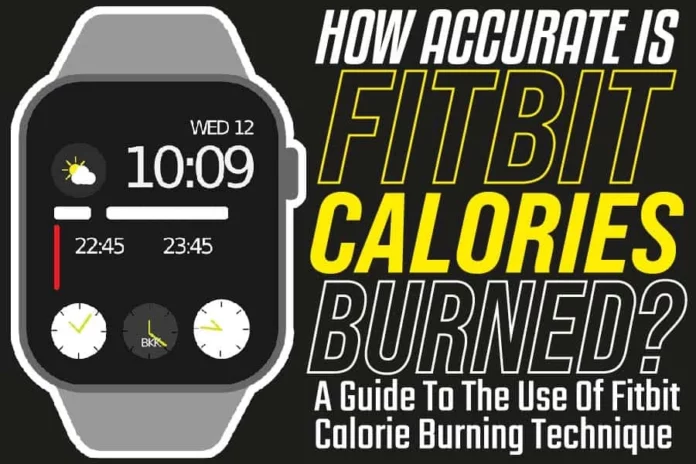Fitbit is a device that assists in tracking your performance by burning calories and losing weight. It records and tracks the number of statistics, including the number of steps taken, the number of floors climbed, the distance traveled, and calories burnt. Activity trackers like Fitbit play a role in improving the overall health of users; the progress you make on these trackers can motivate you to achieve better results. Fitbit can help you set a realistic and achievable goal in the short and long terms.
So, How Accurate are Fitbit Calories Burned?
Fitbit calories burned is not 100% accurate, but in a 2007 survey, Fitbit had a median error of about 27%.
How Fitbit Works
The following are information about the working style of the Fitbit device;
1. How Does Fitbit Count Steps Taken
Whether you are climbing the stairs or running, Fitbit uses the same method of operation to count the total steps taken. It uses a 3 axis accelerometer to count your steps. This sensor will also allow the device to measure your movements’ frequency, intensity, duration, and patterns while you take the steps.
The measurement comprises how you work out. Based on the readings, you can vary the intensity of your workout from time to time.
2. How Does Fitbit Calculate Total Distance Travel?
Fitbit device uses a formula to calculate the total distance traveled. The formula includes the stride length, which is determined by height and sex, and the incremental steps. The formula Fitbit used in calculating total distance travel is;
3. Total distance = steps x stride length.
Once you track your activity with GPS, your Fitbit device will automatically calculate your distance using the GPS data rather than the steps. If your movement begins before receiving a GPS signal, your device will calculate distance using the steps taken until the GPS connects.
If you want to update your stride length, track a run with the GPS or measure your strode length manually.
4. How Does Fitbit Device Calculate Distance Travel
Not all Fitbit devices can count the number of floors climbed. The Fitbit device that counts the number of floors climbed comes with an altimeter sensor that automatically detects when you go up an elevation. Fitbit device will register one floor when you climb about 3 meters o 10 feet.
The device will also make use of changes in barometric pressure and combine this with the number of steps taken to calculate the total number of floors climbed. Remember that the Fitbit device is not designed to count the number of floors on stationary exercise devices like a treadmill or when going down a flight of steps.
It would be best to keep these standard procedures in mind to read the number of floors climbed accurately.
5. How Does Fitbit Calculate the Number of Calories Burnt?
Fitbit calculates the number of calories burnt by combining your basal metabolic rate (BMR) with your activity data.
The BMR is defined as the rate at which your body burns calories at rest to maintain its normal body functions such as blood circulation, breathing, and heartbeat. If your Fitbit tracks your heart rate, for instance, then the data collected will be included, alongside several steps taken, for instance, to calculate your total calories burned.
The number displayed on your Fitbit device is the total calories burnt daily. It may take several hours for the Fitbit device to complete data gathering to calculate your total calorie burned.
Your BMR is corked out based on the data you put into your Fitbit account, and these data include height, sex, weight, and age. Since your body burns calories whether you are sleeping and not moving, you will see calories burned up on the Fitbit device when you wake up, and the number increases throughout the day.
The unit of measurements on Fitbit varies; in some regions or countries, the calories burnt are measured in Kilojoules, and in other places, it is simply calories. You can always change the units of measurement to the ones preferred.
Tips On How To Get Accurate Fitbit Calorie Burning Measurements
To make your Fitbit work better and give you more accurate results, you should consider the following;
1. Wear the Device Correctly
You should wear your Fitbit device correctly on your wrist or top of the clip. If you switch the device to the other wrist, you must update your Fitbit app’s wrist setting.
Confirm Your Personal Information
You need to confirm that your personal information, especially your body measurements are accurate. Your Fitbit account must include accurate information on height, age, sex, and weight.
2. Use Exercise App to Track Your
You can see your real-time heart rate by using the exercise app that is represented by a running man symbol in yellow color. The data obtained here can better determine calories burnt during the exercise, especially for workouts like spinning, yoga, and swimming, where your step count may not reflect the true intensity of the workout.
3. Swing Your Arm Back and Forth While You Move
If you want your Fitbit to count steps while you work and run, you must swing your arm back and forth while you move. If you need both arms for some activity, like when you push a stroller or a dog leash with the same hand your Fitbit device is on, you should consider using the GPS to calculate accurately your distance traveled and calories burned.
4. You Can Always Edit or Remove Your Daily Activity on Fitbit
It is possible to delete your daily activity data on a Fitbit device. If you notice extra steps or floors on your device, for instance, you should log a non-step activity like driving to override such activity.
Changing Your Stride Length On Fitbit Calorie Device
Your stride length will automatically update after you track a run with the GPS. To achieve the best result, you should try and run at a comfortable pace for about 10 minutes.
You can measure your Stride length manually and then add it to your Fitbit account. To measure your Stride length, go to a place where you can exercise under a measured length, for instance, a track. Count your steps as you walk or run on the track and make sure you travel for at least 10 steps.
Divide the distance you traveled in yards or meters by the total number of steps you took to determine your Stride length. If necessary, convert your stride length into meters or inches.
To add your Stride length to your Fitbit app, tap on the “Today” symbol and click on your profile picture. Click on “Activity & wellness,” then click on exercise before clicking “Stride length.” Adjust your stride length if necessary.
Wearing Your Fitbit Device
To wear the infinity bands that come with Fitbit charge 5, Fitbit Sense, and Fitbit Versa 3, you should slide the bottom band through the first loop on the top band. Tighten the band until it is comfortable, then press the peg through one of the holes inside the band.
Tighten the band until it fits comfortably, and press the peg through one of the holes inside the band. Slide the loose end through the second loop until the device lies flat on your wrist.
To wear other brands properly, place the device around your wrist, then fasten the clasp. Wear the band to be slightly loose enough to move back and forth on your wrist.
Securely clip a device with the screen facing outward to your clothing for the clip-based devices. If you have been previously wearing your clip-based Fitbit device in a band, press and hold the button on the device and tap on the wrist (symbolized by a wrist band image) to change the device to the “On Clip,” which is also symbolized by the clip
You can adjust the type of units used in measuring your height, weight, water consumption, and temperatures. To do this, go to the Fitbit app, then click on “Today” and click on your profile picture. Click on “App settings” and click on “Units.” Make the changes you want, and they will be automatically registered.
For the Aria 2 Fitbit range, you can perform this change by clicking on the “Today” tab and then clicking on your profile picture before clicking on your scale icon. Tap on weights units and choose the units that you want the scale to display your readings.
The next moment you sync your scale, you will see your weights displayed in the new units you select. You may have to weigh yourself twice or more to see the new unit displayed.
It is also important that you follow the user manual of your Fitbit device, especially on maintenance care. Lack of proper maintenance perhaps is the reason why many Fitbit devices malfunction.





